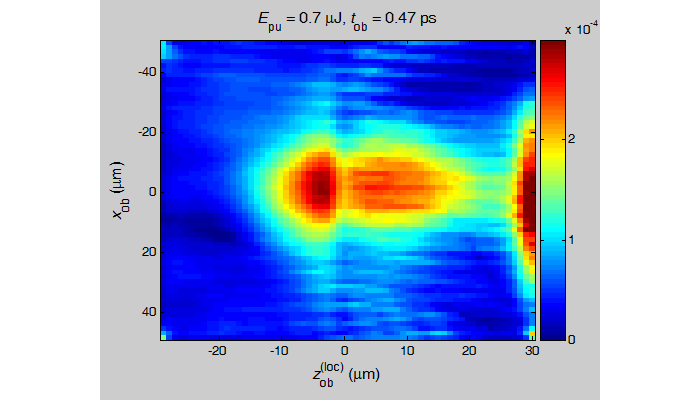Scientists in the Department of Physics have captured the ultimate high-speed movie of a laser pulse as it zips through a piece of glass at the speed of light. The new imaging technique will help scientists understand how intense laser pulses propagate through air, glass fibers and fusion pellets, and thus could have applications in atmospheric chemical analysis, fiber optic communications, and power generation.

The whole movie consists of 61 frames that record the bumpy 15 picosecond ride (a picosecond is one trillionth of a second) of a laser pulse through a glass plate just a tenth of an inch thick. Think of it as a much faster and smaller version of the wake of a boat plowing through water. Instead of a wake in water, the movie shows a tumbling light-speed bubble where the intense laser light momentarily distorts the glass.
"Like a boat going through a lake, it displaces some of the water, pushes it aside and makes a cavity for itself," says Mike Downer, physics professor in the College of Natural Sciences. "And the cavity moves along with the boat, but changes shape depending on what's going on with the boat, like if it rocks back and forth."
To record the action, the scientists fired five weak "probe" laser pulses like a crossfire of bullets across the bubble's path at different angles. They then reconstructed the movie from the five recordings using computerized tomography (CT), the same technique doctors use to reconstruct images of internal bodily organs.
So why does the world need this new imaging technique?
Physicists might use it to explore how exotic structures called optical rogue waves form in their laser experiments, which in turn might shed light on how naturally occurring rogue waves – unusually large and destructive ocean waves that seem to come out of nowhere – form. Physicists might use the technique to develop better ways to ignite nuclear fusion reactions for power generators.
Downer plans to use the technique to visualize the internal workings of a new type of laser-driven particle accelerator he and his team are developing.
"Previously, people would have to use computer simulations to understand what was happening in these small, high speed laser-created structures," says Downer. "Now we can look directly inside and see for ourselves."
To read more about the scientists' tour-de-force of cinematography, check out their article "Single-shot tomographic movies of evolving light-velocity objects" in the journal Nature Communications: http://www.nature.com/ncomms/2014/140122/ncomms4085/full/ncomms4085.html

















Comments